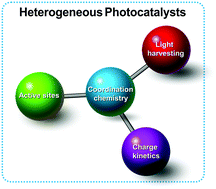Coordination chemistry in the design of heterogeneous photocatalysts
Abstract
Heterogeneous catalysts have been widely used for photocatalysis, which is a highly important process for energy conversion, owing to their merits such as easy separation of catalysts from the reaction products and applicability to continuous chemical industry and recyclability. Yet, homogenous photocatalysis receives tremendous attention as it can offer a higher activity and selectivity with atomically dispersed catalytic sites and tunable light absorption. For this reason, there is a major trend to combine the advantages of both homogeneous and heterogeneous photocatalysts, in which coordination chemistry plays a role as the bridge. In this article, we aim to provide the first systematic review to give a clear picture of the recent progress from taking advantage of coordination chemistry. We specifically summarize the role of coordination chemistry as a versatile tool to engineer catalytically active sites, tune light harvesting and maneuver charge kinetics in heterogeneous photocatalysis. We then elaborate on the common fundamentals behind various materials systems, together with key spectroscopic characterization techniques and remaining challenges in this field. The typical applications of coordination chemistry in heterogeneous photocatalysis, including proton reduction, water oxidation, carbon dioxide reduction and organic reactions, are highlighted.



 Please wait while we load your content...
Please wait while we load your content...